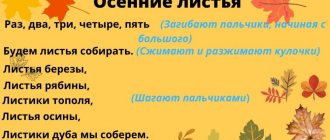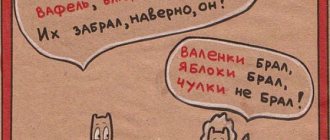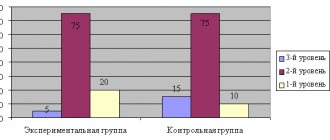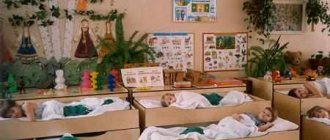Children's perception of fiction and folklore in early preschool age
We use children's folklore in various activities:
when introducing children to Russian national culture;
in folk outdoor games;
in games to develop fine motor skills;
in theatrical activities,
as well as in direct educational activities and in regime moments.
Works of folk art accompany the kids in our group throughout the day. The morning begins with a nursery rhyme: “Early and early in the morning.” When washing: “Water, water”, “Scented soap, white, soapy”, “Oh, okay, okay, okay”, “Wash cleaner, don’t be afraid of water”, “From some water, from some water”, “We know, we know, Yes Yes Yes". When grooming a child, we accompany our actions and manipulations with objects with nursery rhymes: “I’ll braid my hair,” “Grow, braid, to the waist.” Dressing for the street: “We have chubby little hands”, “For my baby”, “If you want to go for a walk, you need to get dressed quickly.” The children listen with great interest and repeat the movements performed by the teacher to lullabies - rocking the doll, putting it to sleep: “Lyushenki - Lyuli”, “Bayu - bayushki - bayu”. In educational activities and joint activities, the children listen carefully to fairy tales: “Ryaba the Hen”, “Turnip”, “Teremok”, “Rukavichka” and others, which are understandable and accessible to children. The heroes of fairy tales speak, perform actions, thereby introducing children to their habits, living conditions, forming knowledge about “good” and “evil”, about caring for the natural world. Through artistic images, the child learns to understand the work and respond emotionally to it. Performances are staged based on all the fairy tales read. To memorize and reproduce fairy tales in our work, we use “fairytale cubes” with images of fairy-tale characters. Acquaintance with the fairy tale was carried out in the following sequence: table theater or “fairy tale cubes”, dramatization game, dramatization game, reading and showing illustrations. The retelling occurs using mnemonic tables or illustrations of the tale. To attract the attention of children at the organizational moment of NOD, we dress up as various characters: Fox-Patrikeevna, Kolyada, Kot-Bayun, etc. The group often listens to audio recordings of fairy tales and other folklore forms.
The children play folk games with great desire: “Geese-geese”, “Bear”, “Hide and Seek”, “Alyonushka and Ivanushka”, “Frost”, “Wolf and Sheep”. During music classes, children are introduced to round dance games, elements of folklore, and folk instruments.
As an example, let’s consider the logic of complex direct educational activities (second junior group) on speech development: dramatization of the Russian folk tale “Rukavichka” and artistic and aesthetic development (modeling) “The little gray bunny is sitting...” with the integration of educational areas: “Social and communicative development” “Cognitive development”, “Speech development”, “Physical development”.
Familiarization of preschool children with fiction
Such a conversation may include: a short story about the writer, a reminder of his other books that are already familiar to children. If children have been prepared by previous work to perceive a book, you can arouse their interest with the help of a riddle, a poem, or a picture. Next, you need to name the work, its genre (story, fairy tale, poem), and the name of the author.
Explanation of unfamiliar words is a mandatory technique that ensures a full perception of the work. It is necessary to explain the meanings of those words, without understanding which the main meaning of the text, the nature of the images, and the actions of the characters become unclear. The explanation options are different: substituting another word while reading prose, selecting synonyms (bast hut - wooden, upper room - room); the use of words or phrases by the teacher before reading, while introducing the children to the picture (“milk flows down the mark, and from the mark down the hoof” - when looking at the goat in the picture); asking children about the meaning of a word, etc.
Expressive reading, the interest of the teacher himself, his emotional contact with children increase the degree of impact of the literary word. While reading, children should not be distracted from perceiving the text with questions or disciplinary remarks; raising or lowering the voice or pausing is enough.
At the end of reading, while the children are impressed by what they heard, a short pause is necessary. Should we immediately move on to an analytical conversation? E. A. Flerina believed that it is most appropriate to support childhood experiences and strengthen the elements of analysis during repeated reading. A conversation started on the initiative of the teacher will be inappropriate, as it will destroy the impression of what was read. You can ask whether you liked the fairy tale and emphasize: “A good goldfish, how it helped the old man!”, or: “What a Zhikharka! Small and remote!”
At the end of the lesson, you can re-read the work (if it is short) and look at the illustrations, which deepen your understanding of the text, clarify it, and more fully reveal artistic images.
The method of using illustrations depends on the content and form of the book, and on the age of the children. The basic principle is that showing illustrations should not violate the holistic perception of the text. The main task of reading for a preschooler is to teach him to listen and hear (correctly perceive speech). A picture—an illustration placed in a children's book—helps the teacher present the child with a readable text, but it can also interfere with comprehension if shown at the wrong time.
When introducing a new book, it is advisable to first read the text to the children, and then look at the illustrations with them. It is necessary that the picture follows the word, and not vice versa - otherwise a bright picture can captivate children so much that they will only imagine it in their minds; the visual image will not merge with the word, because children will not “hear” the word, its sound shell they won't be interested. The exception is the colorful cover of the book, which arouses the natural interest and curiosity of children in this book.





